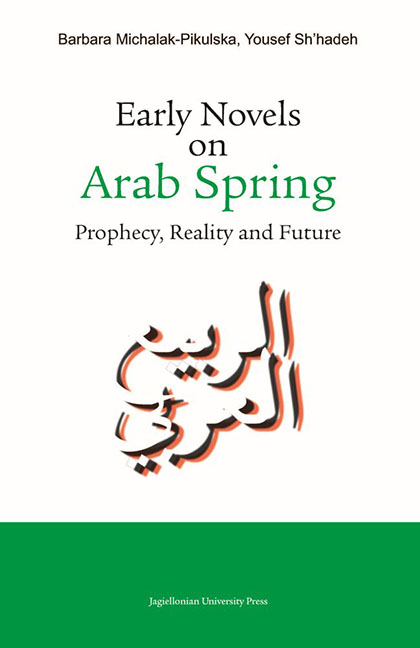Book contents
- Frontmatter
- Contents
- Introduction
- Part I Awakening of the Awareness of Subjugation – The Prophecy of the Spring of Nations in Arab Novels
- Part II At the Heart of the Arab Spring Events
- Part III The Future: The Spring Continues
- 17 Mu‘Taṣim Aš - Šā‘Ir : Uhzūǧat ar-raḥīl (A Song of Departure) and Fī intiẓār as-sulaḥfāt (Waiting for a Turtle)
- 18 Aḥmad ‘Abd Al - Malik : Al-Aqni‘a (Masks)
- 19 Ṭayba Aš - Šarīf Al - Idrīsī : Ḥaǧar min saqar (A Stone from Hell)
- 20 Amīra Aš - Širbīnī : ‘Itq (Liberation)
- 21 ‘ Izz Ad - Dīn Šukrī Fašīr : Bāb al-ẖurūǧ – risālat ‘Alī al-muf‘ama bi-bahǧa ġayr mutawaqqa‘a (The Gate to Leave – Ali’s Letter Filled with Unexpected Joy)
- Conclusion
- Bibliography
- Summary in Arabic
Part II - At the Heart of the Arab Spring Events
Published online by Cambridge University Press: 13 October 2023
- Frontmatter
- Contents
- Introduction
- Part I Awakening of the Awareness of Subjugation – The Prophecy of the Spring of Nations in Arab Novels
- Part II At the Heart of the Arab Spring Events
- Part III The Future: The Spring Continues
- 17 Mu‘Taṣim Aš - Šā‘Ir : Uhzūǧat ar-raḥīl (A Song of Departure) and Fī intiẓār as-sulaḥfāt (Waiting for a Turtle)
- 18 Aḥmad ‘Abd Al - Malik : Al-Aqni‘a (Masks)
- 19 Ṭayba Aš - Šarīf Al - Idrīsī : Ḥaǧar min saqar (A Stone from Hell)
- 20 Amīra Aš - Širbīnī : ‘Itq (Liberation)
- 21 ‘ Izz Ad - Dīn Šukrī Fašīr : Bāb al-ẖurūǧ – risālat ‘Alī al-muf‘ama bi-bahǧa ġayr mutawaqqa‘a (The Gate to Leave – Ali’s Letter Filled with Unexpected Joy)
- Conclusion
- Bibliography
- Summary in Arabic
Summary
Shortly after the outbreak of the Arab revolutions, objectives and aspirations of the Arab Spring began to become clear, which would constitute a watershed moment in contemporary Arab history. Many writers began to work on texts describing what happened during the rise of Arab societies. Relatively many novels were published during the first two years of the Arab Spring (2011–2012), inspired by the mass movement, including the peaceful demonstrations and the revolutions that expressed the demands of simple people and their challenge to despotic regimes. Most of these works deal in depth with the Egyptian January 25 revolution, particularly with the events that took place in Tahrir Square, which has become a symbol of the Arab Spring. Seven novels written by Egyptian and other Arab authors will be brought to the fore here, as they provide a realistic and comprehensive picture of the course of the revolution that broke out in Egypt in 2011, namely: 7 ayyām fī at-Taḥrīr (7 Days on Tahrir Square) by Hišām al-Ḫašin, Wa al-malā’ika ayḍan taṣ‘ad li-ṭ-ṭābiq aṯ-ṯāliṯ (And the Angels Also Reach the Third Floor) by Šarīf Malīka, Dafātir qadīma (Old Notebooks) by Hišām ‘Alwān, Tāǧ al-hudhud (Hoopoe Crown) by Nāṣir ‘Irāq, Fustān faraḥ (A Wedding Dress) by Rabāb Kassāb, Šibh dawla (State-like) by Muḥammad Ǧarrāḥ, and Aḥlām mamnū‘a (Forbidden Dreams) by Nūr ‘Abd al-Maǧīd.
Besides the abovementioned works, four novels that depict the beginnings of the insurrections in Libya and Syria, and the struggle of large groups of people opposing to bloody despotic regimes in these two countries, will also be analyzed. They are as follows: Fī ḍiyāfat katā’ib al-Qaḏḏāfī (Hosted by Gaddafi Troops) by Aḥmad Fāl Wuld ad-Dīn, ‘Aduww aš-šams – al-bahlawān al-laḏī ṣāra waḥšan (The Enemy of the Sun – a Clown Who Has Become a Beast) by Muḥammad Saʻīd ar-Rīḥānī, Fursān al-aḥlām al-qatīla (Knights of Slain Dreams) by Ibrāhīm al-Kūnī, and Kāna ar-ra’īs ṣadīqī (The President Was My Friend) by ‘Adnān Farzāt.
- Type
- Chapter
- Information
- Early Novels on Arab SpringProphecy, Reality and Future, pp. 29 - 30Publisher: Jagiellonian University PressPrint publication year: 2022

